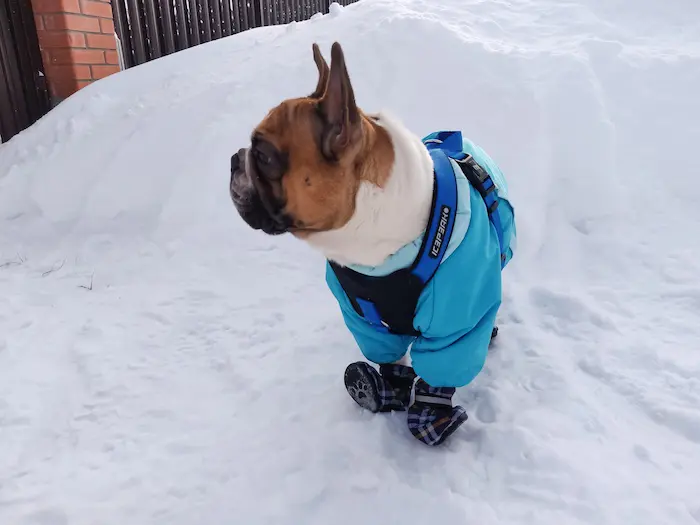
As soon as the cold weather hits, it’s time to check out the latest dog winter coats, boots, sweaters and safety gear. Pet parents should be especially careful if they have small dogs or a breed with thinner fur, so we’ve got tips and solutions to help you and your pet brave any weather.
Discover how to keep your dog warm in cold temperatures and learn about the importance of winter dog coats, dog shoes, reflective accents and more.
Winter Challenges for Dogs
For some dogs (looking at you, huskies), a dog coat or boots simply aren’t necessary — even in the coldest winter destinations. However, for many dogs, including small breeds and short-haired dogs, a dog jacket and protection for paws are essential in winter. That’s because winter conditions, rain and snow pose unique risks to puppies and dogs, but not going outdoors simply isn’t an option.
Breeds such as dachshunds, greyhounds, pugs, boxers and Dobermans are especially vulnerable to the cold. When the temperature falls below 45 degrees Fahrenheit, water-resistant dog jackets and boots become crucial for dogs with short coats and exposed extremities. One of the biggest risks during cold weather is hypothermia, a life-threatening condition where the dog’s body temperature falls below normal. Signs of hypothermia include shivering, lethargy, muscle stiffness and shallow breathing.
Another challenge your dog might face in winter is frostbite, which is most dangerous for a pup with exposed extremities, such as a Chihuahua, bulldog, Dalmatian or whippet. These breeds possess short coats and often have exposed skin on their ears, noses or toes, putting them at an increased risk in freezing temperatures.
To avoid these risks becoming problems, invest in appropriate gear, including durable dog winter coats, dog jackets, sweaters, dog shoes and other tools to protect your pup from the elements.
The Essential Winter Gear for Dogs
In the toolkit of clothes and accessories that benefit pups when it comes to keeping the heat in, waterproof winter dog coats and boots stand out as being indispensable. Wearing these items protects your dog’s well-being, shielding sensitive areas and offering warmth during bitingly chilly temperatures.
A dog coat, dog jacket or sweater serves as a thermal layer or second skin, helping prevent hypothermia and keep your pet warm and comfy. It should be a well-fitting outer shell with the correct chest girth and enough space for your dog’s legs, tail and harness, if necessary. Shoes protect sensitive paws from the ice and snow, in addition to preserving paw health by defending dog toes against salt and deicing agents.
Safety accessories, such as safety vests and collars, add an extra layer of protection during winter, increasing your dog’s visibility and reducing the risk of accidents. Investing in the right winter gear means you and your four-legged friend can enjoy winter adventures while staying safe and warm.

Choosing the Right Dog Boots
When your pup goes to the dog park in winter, it should wear a warm waterproof dog coat, sturdy leash and harness, safety equipment and dog boots. Here’s how to choose the right dog boots for your pet.
- Size: First and foremost, be sure to get the right size. Poorly fitting dog boots can cause discomfort and might even fall off in the rain, mud or snow. Carefully measure the length and width of your dog’s paws and match them to the specific manufacturer’s guide to ensure a snug yet comfy fit.
- Material: Ideally, winter dog shoes should be made from hard-wearing, waterproof material to keep your pet’s paws dry in the snow and rain. If you live in a state with very cold winters, opt for thicker boots. For places with mild winters, make sure dog boots are breathable.
- Comfort: Boots that have a soft lining can prevent chafing and offer your dog extra warmth, and a secure closure keeps them in place during fun outdoor adventures. If your dog has dewclaws, select a design that can accommodate the extra digits.
- Traction: Opt for sturdy, nonslip soles that help your dog navigate icy or wet surfaces with ease. Make sure the soles are flexible enough to allow for movement but thick enough to protect your dog’s paws from sharp objects.
- Breed-specific considerations: Each breed has a unique paw shape and size. While larger dogs might have more rounded paws and require boots with a large opening, it’s important to choose a snugger fit for smaller dogs with slimmer legs and narrower paws.
- Style: Choose something that suits you and your pet’s personalities and makes you both happy.
Introduce your dog to wearing shoes gradually so it can get used to the sensation of having something on its feet. Give it a treat for positive interactions with the boots and eventually, it will come to accept them. Keep in mind that forcing your dog to wear them without training could create a negative association that’s very hard to break.
Some dogs are simply too small and fragile to go outside in severe winter conditions. If that sounds like your dog, make sure it gets plenty of indoor exercise and stays active during the colder months.
Winter Safety Tips for Dog Owners
As the cold weather takes hold, the number of safety measures you take to keep your dog safe should increase. Here’s a guide to making the most of winter with a canine companion.
- While out walking, go for well-lit routes and stick to paths that are well-maintained to avoid hidden ice. If you don’t get dog boots, be sure to get wax for your dog’s paws for protection from the cold. Always be wary of hidden obstacles, such as rocks and uneven surfaces beneath the snow.
- Explore winter sports for dogs, such as skijoring, dog-friendly snowshoeing or winter agility courses. Invest in outdoor dog toys, such as snowball launchers, scented snow toys and rubber fetch toys.
- Don’t leave home without reflective accents to keep your dog extra-safe from cyclists, vehicles and other pedestrians in the dark.
- When taking your dog on snowy adventures, go the extra mile to protect it by getting a Halo Collar 3. It has an advanced lighting system for enhanced visibility in low-light conditions, real-time GPS tracking via an app on your smartphone and a wireless dog fence system — and it’s waterproof.
Implementing these tips and exploring high-tech solutions such as the Halo Collar 3 can soothe any worries you might have about taking your dog out in the dark winter months.
Conclusion: Gear Up for Pawsitive Winter Adventures
Gearing up for winter means having the right dog snow gear to ensure your pet’s safety and comfort. For breeds that are susceptible to cold weather, waterproof dog coats and boots are essentials, guarding against health issues like hypothermia and frostbite.
Getting the size and fit right won’t just keep your dog warm; it’ll protect its paws against hidden sharp objects in the snow and can prevent it from slipping on icy surfaces. Winter sports and activities can strengthen the bond between you and your pet, while high-tech solutions such as the Halo Collar 3 offer peace of mind during high-energy winter adventures.






